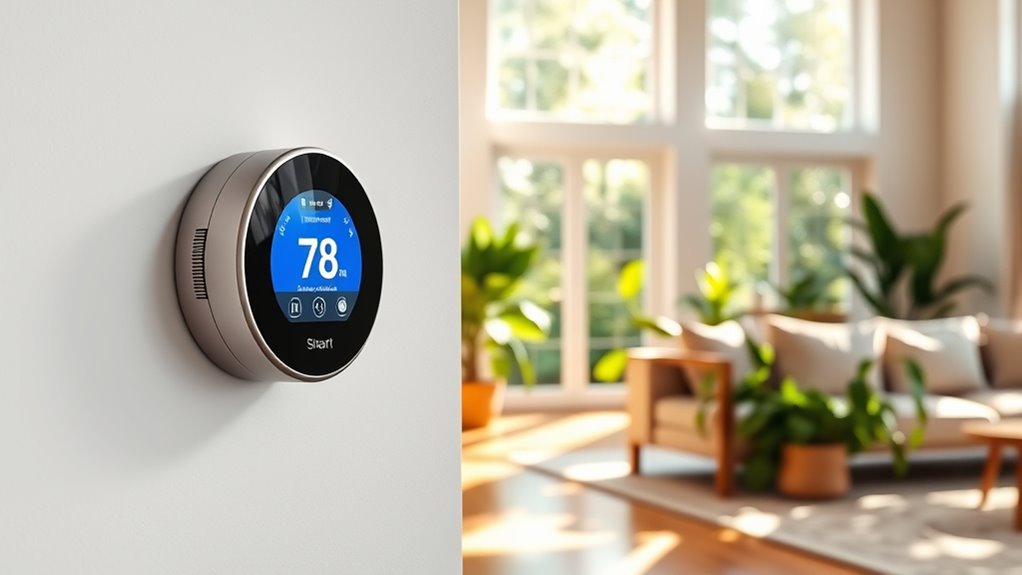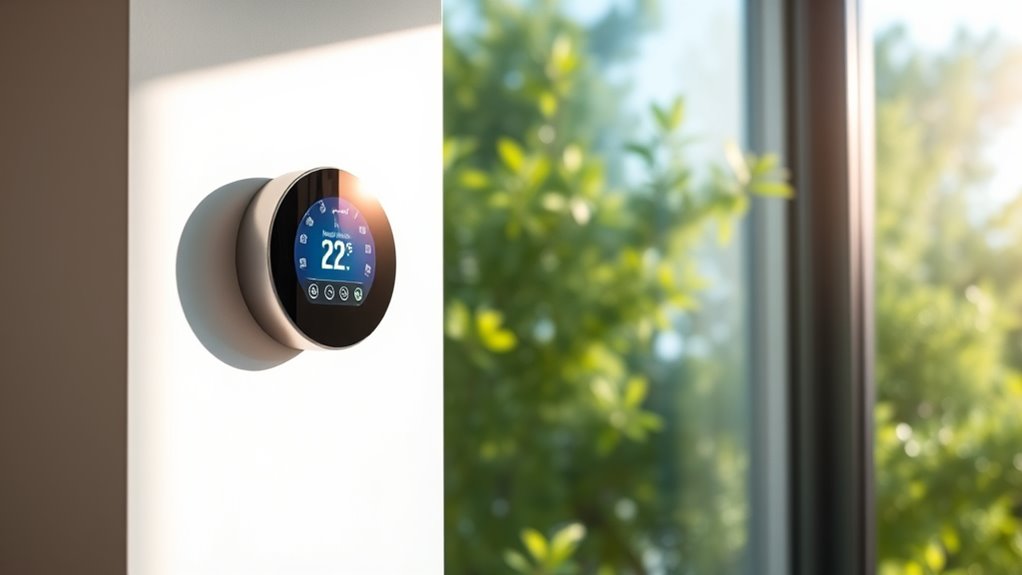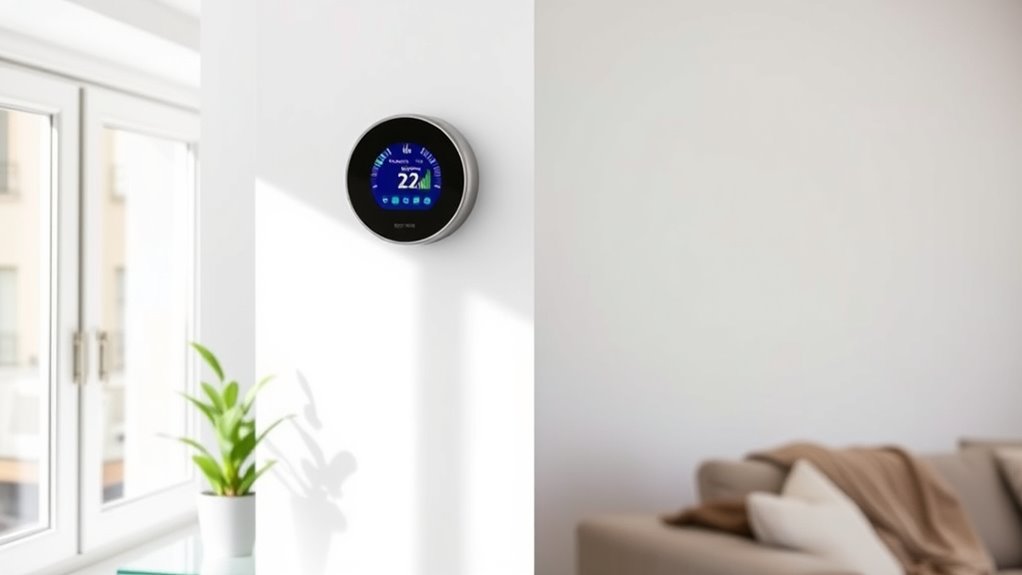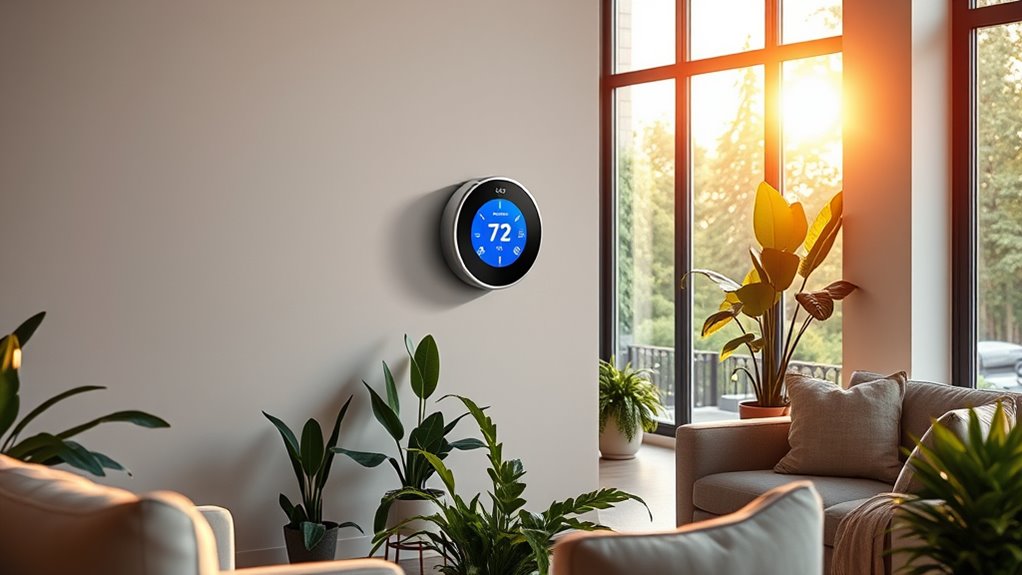Smart thermostats cut your energy bills and carbon footprint by intelligently learning your habits, adjusting heating and cooling based on occupancy, weather, and preferences. They optimize HVAC use, reducing unnecessary energy waste, and often include features like remote control and sensors to further boost efficiency. With savings up to 23% on energy costs and significant environmental benefits, discovering how you can maximize these devices can lead to smarter, cost-effective choices for your home. If you’re curious, there’s more to explore about their benefits and future trends.
Key Takeaways
- Smart thermostats learn user routines and adjust heating and cooling schedules to minimize unnecessary energy use.
- Features like occupancy detection and geofencing automatically turn off or reduce HVAC operation when spaces are unoccupied.
- Real-time sensors and weather data enable preemptive adjustments for optimal comfort and energy efficiency.
- Remote control and energy reports help users monitor and optimize consumption, reducing waste and bills.
- By optimizing energy use, smart thermostats significantly lower greenhouse gas emissions and carbon footprints.
The Financial Benefits of Smart Thermostats

Smart thermostats offer significant financial benefits by helping you lower your energy bills each year. On average, you can save about 8% annually, which amounts to roughly $50 for most households. Savings tend to be higher in regions with extreme temperatures or high energy costs. These devices optimize heating and cooling by turning systems off when they’re not needed, preventing energy waste. Automated, pattern-learning adjustments reduce manual input and avoid overheating or overcooling, boosting savings. While the initial cost might be higher than traditional models, the energy savings quickly offset this expense. Many utility companies also provide rebates or incentives, further reducing your upfront costs. Over time, these savings add up, making smart thermostats a smart financial choice. Implementing energy-efficient practices can further enhance your savings and reduce your carbon footprint over time. Additionally, understanding energy consumption patterns helps maximize the benefits of these devices, especially when combined with behavioral adjustments to optimize efficiency.
How Smart Thermostats Reduce Energy Consumption

By automatically learning your temperature preferences and daily routines, smart thermostats can optimize your heating and cooling schedules without you having to lift a finger. They adjust setpoints based on occupancy detection, turning off or reducing HVAC when spaces are empty, which cuts wasted energy. These devices also nudge you toward efficiency by reporting energy use and suggesting adjustments. Learning from your patterns helps avoid unnecessary temperature swings, maintaining comfort while lowering consumption. Additionally, real-time sensors and weather forecasts enable preemptive adjustments, preventing system overload during extreme conditions. Occupancy sensors and geofencing ensure HVAC runs only when needed, avoiding energy waste during absences. Moreover, understanding Resources and Tools available for energy management can further enhance your home’s efficiency. For example, integrating smart technology features allows for more precise control and further energy savings. For instance, integrating Kia Tuning techniques such as ECU remapping or suspension upgrades can optimize vehicle performance and fuel efficiency, complementing your home’s energy savings efforts. Smart thermostats also benefit from noise level considerations, ensuring quieter operation that maintains comfort without adding disturbance. Considering energy monitoring systems can provide insights that help you fine-tune your home’s energy use, leading to even greater savings. Together, these features can reduce energy use by 10–15%, making your home more efficient and eco-friendly.
Environmental Impact and Carbon Emission Savings

Implementing smart thermostats can greatly reduce your home’s carbon footprint because they optimize energy use through advanced sensors and algorithms. By adjusting heating and cooling based on occupancy and preferences, they cut unnecessary energy consumption, leading to lower greenhouse gas emissions. Globally, if widely adopted by 2050, smart thermostats could be installed in over half of households with internet access, potentially reducing emissions by up to 7.25 gigatons of CO2 equivalent. This significant impact supports climate change mitigation efforts while also saving you money on utility bills. As you personalize schedules and utilize energy insights, you contribute to a more sustainable environment. Incorporating energy-saving practices such as using programmable settings can further enhance efficiency. Leveraging smart technology that learns from your habits can optimize energy use even more effectively. Investing in smart thermostats is a practical step toward reducing your carbon footprint and promoting cleaner, greener living.
Key Technologies Powering Smart Thermostats

The core technologies behind smart thermostats enable seamless connectivity, intelligent data processing, and user-friendly automation. Wi-Fi allows you to control your thermostat remotely via mobile apps and cloud services, while multi-room sensors monitor temperature variations across zones for precise comfort. Cloud-based analytics analyze your usage patterns and weather data to optimize HVAC performance automatically. IoT integration connects your thermostat with other smart home devices, creating a unified energy management system. Machine learning algorithms track occupancy schedules, predict heating and cooling needs, and detect anomalies like inefficient operation. Sensor technologies, including temperature, humidity, and light sensors, fine-tune settings based on environmental conditions. Real-time monitoring further enhances efficiency by providing immediate feedback on system performance. Incorporating energy-saving strategies such as adaptive scheduling and occupancy detection allows smart thermostats to maximize savings without compromising comfort. Additionally, the integration of advanced sensors ensures more accurate environmental readings, further optimizing energy use. The use of personalized user preferences helps tailor the system to individual comfort needs, improving overall satisfaction. Moreover, these innovations are often supported by regular software updates that introduce new features and enhance security. Together, these innovations enable smart thermostats to adapt efficiently, reducing energy waste and enhancing your comfort with minimal effort.
Return on Investment and Cost Savings

Investing in a smart thermostat pays off quickly, with most units recouping their costs within a few years through energy savings. Utility rebates and government incentives can further reduce your upfront expenses and boost your overall savings. Over the long term, these devices deliver substantial financial benefits while helping lower your carbon footprint. If issues like emotional coldness or daily frustrations arise in relationships, seeking professional help can be beneficial for resolution.
Cost Recovery Timeline
Smart thermostats typically cost between $100 and $300, with installation adding another $50 to $150 if you choose professional help. You can expect a payback period of about 1 to 3 years, depending on your home’s size, climate, and HVAC efficiency. The more you optimize settings—like adjusting temperatures or using features like recovery mode—the faster you’ll see savings. According to the U.S. Department of Energy, reducing your thermostat by 7 to 10 degrees for 8 hours daily can cut annual heating and cooling costs by around 10%. Over time, these savings build up, covering your initial investment and then some. Plus, better HVAC operation extends system life and reduces maintenance, further accelerating your cost recovery timeline. Properly managing your thermostat settings can also minimize energy waste and enhance your overall savings. Implementing smart scheduling and automation features can further improve your energy efficiency and savings. Additionally, integrating smart features such as air quality monitoring can help optimize indoor environments and improve energy efficiency.
Incentives Enhance Savings
Incentive programs play a crucial role in boosting the adoption of smart thermostats by lowering upfront costs through rebates and credits. These incentives make it easier for you to see quick savings and improve your return on investment. They reduce initial expenses, helping you save 8–15% on heating and cooling bills, especially in harsh climates. To visualize, here’s how incentives impact savings:
| Incentive Type | Benefit |
|---|---|
| Rebates and credits | Lower initial costs, faster ROI |
| Seasonal promotions | Increased adoption, short-term boosts |
| Federal and local credits | Maximize overall savings |
With these incentives, you can realize quicker savings, making smart thermostats more accessible and financially attractive. Proper understanding of regulatory compliance ensures that your energy-saving investments adhere to relevant standards and laws. Incorporating energy-efficient technologies can further enhance your savings and environmental impact. Additionally, staying informed about industry standards helps optimize your smart thermostat setup for maximum efficiency. Recognizing the importance of government incentives can also motivate further adoption and support sustainable practices. Moreover, understanding the safety features of electric devices, like safety of electric heated mattress pads, ensures that your home remains secure while benefiting from energy-efficient solutions.
Long-term Financial Benefits
Over time, installing a smart thermostat can deliver substantial financial benefits by consistently reducing your utility bills. On average, users save around 8% on heating and cooling, which can amount to about $50 annually. Some studies, like those on Nest users, show savings up to 12% on heating and 15% on cooling, roughly $140 per year. Ecobee reports savings up to 23%, or about $200 annually. The payback period is short—most households recover their initial $200 investment within 1-2 years. Over the lifespan of the device, these savings add up considerably, with nationwide projections reaching over $2 trillion. As adoption grows, the collective savings and benefits to the grid will increase, making smart thermostats a smart financial move. Being aware of energy efficiency practices can further enhance these savings and environmental benefits.
Enhancing Home Comfort and User Experience

Have you ever wished your home’s temperature could automatically adjust to your comfort preferences? Smart thermostats make that possible by learning your habits and adjusting the temperature accordingly. They use sensors to detect which rooms are occupied and modify settings to keep you comfortable while conserving energy. You can control your thermostat remotely through a smartphone app, giving you the power to change temperatures from anywhere. Scheduling features let you set personalized comfort levels, and real-time energy reports help you monitor usage. Some models even connect with voice assistants for hands-free control. With these features, your home stays cozy without waste, creating a seamless user experience that balances comfort and efficiency. This smart technology ensures you enjoy perfect comfort while reducing unnecessary energy consumption.
Overcoming Barriers to Adoption

You might hesitate to adopt a smart thermostat because of the high upfront costs and uncertainty about its value. Technical compatibility issues and limited internet access can also make installation and use challenging. Addressing these barriers requires targeted incentives, improved education, and efforts to make technology more accessible.
Cost and Awareness Barriers
Cost and awareness barriers substantially hinder the widespread adoption of smart thermostats. The high upfront cost makes many consumers hesitant, especially those with limited budgets who prioritize immediate expenses over long-term savings. Incentives from governments or utilities can help reduce this barrier, but perception remains a challenge, as some see the device as expensive without clear value. Additionally, many potential users lack understanding of the energy and cost savings smart thermostats offer. Confusion about features and benefits, along with concerns about installation complexity and compatibility issues, further discourage adoption. Educating consumers through straightforward information, customer support, and transparent communication about savings can build trust. Addressing both cost concerns and knowledge gaps is essential to increase adoption and unbolt the full benefits of these devices.
Technology Accessibility Challenges
Addressing technology accessibility challenges is essential for expanding smart thermostat adoption among diverse users. These barriers can prevent many from benefiting from energy savings and convenience. To overcome these issues, designs must accommodate mobility, sensory, and cognitive needs. Features like voice control, large displays, and auditory feedback make devices more accessible. Ensuring compatibility with existing systems and simplifying installation also helps reduce barriers. The table below highlights key accessibility needs and solutions:
| Need | Challenge | Solution |
|---|---|---|
| Mobility impairments | Difficult manual controls | Voice commands, remote access |
| Sensory impairments | Visual or hearing limitations | Large displays, auditory alerts |
| Cognitive challenges | Memory or comprehension issues | Automations, simple interfaces |
| Compatibility & setup | Technical complexity | Easy installation, universal compatibility |
Future Trends in Smart Thermostat Usage

As smart thermostat technology continues to evolve, future trends point toward even greater integration, efficiency, and personalization. You’ll see AI and machine learning become smarter, predicting your needs more accurately and adjusting settings automatically. Geofencing will refine temperature control based on your location, saving energy when you’re away. Voice control will become more seamless, allowing hands-free adjustments through popular assistants like Alexa or Google Assistant. Additionally, these devices will integrate into broader smart home ecosystems, providing a unified experience. Expect to access detailed energy reports that help you optimize usage further. As the market grows—projected to reach USD 30.2 billion by 2035—you’ll benefit from smarter, more intuitive thermostats that reduce costs and environmental impact even more effectively.
- AI-driven predictions and adjustments
- Enhanced voice and remote control
- Deeper integration with smart home systems
Frequently Asked Questions
How Do Smart Thermostats Adapt to Different Climates Worldwide?
You might wonder how smart thermostats adapt to different climates worldwide. They use sensors, algorithms, and weather data to optimize heating and cooling based on your local conditions. In cold regions, they focus on reducing heat loss, while in warm areas, they manage cooling efficiently. They learn your schedule, adjust for weather changes, and even control specific zones, ensuring comfort and energy savings no matter where you are.
Are There Privacy Concerns With Data Collection From Smart Thermostats?
Are you worried about your privacy when using smart thermostats? It’s a valid concern, as many manufacturers collect data without clear explanations, and only a few guarantee your information isn’t sold or misused. While these devices offer energy savings, you should look for transparent policies, user consent, and strong security measures. Educate yourself on how your data is handled, and choose brands committed to protecting your privacy.
Can Smart Thermostats Be Integrated With Existing Home Automation Systems?
You can definitely integrate smart thermostats with your existing home automation systems. They often connect wirelessly via Wi-Fi and work seamlessly with platforms like Amazon Alexa, Google Home, and Apple HomeKit. This allows you to control your climate settings through voice commands or automation routines alongside other smart devices. Just make sure your HVAC system is compatible, and consider professional assessment if needed for a smooth, efficient setup.
What Maintenance Is Required for Optimal Smart Thermostat Performance?
To keep your smart thermostat performing well, you should regularly update its software and firmware, check wiring connections for damage or looseness, and replace batteries if it behaves erratically. Conduct monthly inspections for physical damage, guarantee HVAC system components like filters are maintained, and avoid frequent on/off cycling. Cleaning the device and scheduling professional HVAC checkups also help maintain ideal performance and extend its lifespan.
How Do Different Brands Compare in Energy Savings and Features?
You’re curious about how brands compare in energy savings and features. Ecobee offers the highest potential savings, up to 23%, with advanced features like weather integration and multi-stage heating. Nest provides solid savings of around 10–12%, focusing on learning capabilities and remote access. Honeywell and Emerson offer moderate savings, mainly with programmable models. When choosing, consider your budget, desired features, and compatibility to find the best fit for your home.
Conclusion
Embracing smart thermostats gently guides you toward a more sustainable future, where comfort and savings seamlessly intertwine. As you explore this technology, you’ll find yourself enjoying a warmer home with less energy waste, quietly contributing to a healthier planet. With each small step, you create a brighter, greener outlook—where convenience and conservation dance together effortlessly, making every degree a mindful choice for you and the world around you.









